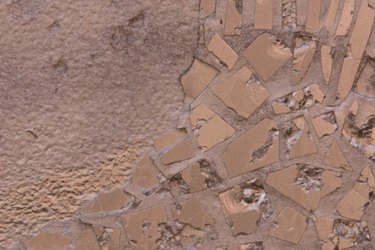Things You'll Need
Garden hose
Spray nozzle
5-gallon plastic bucket

Cutting concrete with a power saw produces enormous amounts of dust. When the dust becomes airborne, it's possible to inhale it into your lungs, which can create severe health problems. While you can find vacuum systems designed to collect the dust material, the systems aren't fully effective. Applying water to the cutting blade or concrete surface using either a garden hose or plastic bucket appears to be the best method for controlling the dust produced by the blade.
Garden Hose
Step 1
Attach the garden hose to a nearby outdoor water spigot. Connect the spray nozzle to the garden hose. Turn the water on.
Video of the Day
Step 2
Wet down the area before starting the cut. The surrounding wet surface aids in collecting the dust.
Step 3
Adjust the outdoor spigot valve so it emits a small, steady stream of water from the spray nozzle when you fully depress the handle.
Step 4
Employ a helper to operate the spray nozzle. Direct the stream of water at the blade when cutting the concrete.
Plastic Bucket
Video of the Day
Step 1
Make a small hole, 1/8-inch in diameter, in the bottom side of the 5-gallon plastic bucket.
Step 2
Fill the bucket with water.
Step 3
Set the bucket next to the cutting line. Orient the hole so water weeps onto the cutting area.
Step 4
Move the bucket as needed to keep the water concentrated over the appropriate section of concrete cutting.
Tip
Wear proper personal protection equipment such as eye and hearing devices. Shoes and clothes will also get wet during the cutting process. You can obtain concrete cutting saws from equipment rental agencies. Many saws come equipped with a water application system. The rental agency provides training on the safe operation of the tool. Using a chalk line marking system is not effective when using water dust control methods, as the chalk will wash way during the cutting process. Instead, make the line with a wax crayon or a permanent paint application. Make sure the electric saw, if applicable, is plugged into a Ground Fault Circuit Interrupter, or GFCI, outlet to protect the operator from electric shock hazards.
- United Kingdom Health and Safety Executive: Dust Control on Cut-Off Saws for Stone or Concrete Cutting; February 2010
- Centers for Disease Control and Prevention: In-Depth Survey for Dust Control; Alan Echt, et al.; April 2007
- Fine Home Building: Dust Control When Cutting Concrete; John Lindsay Jr; September 2008